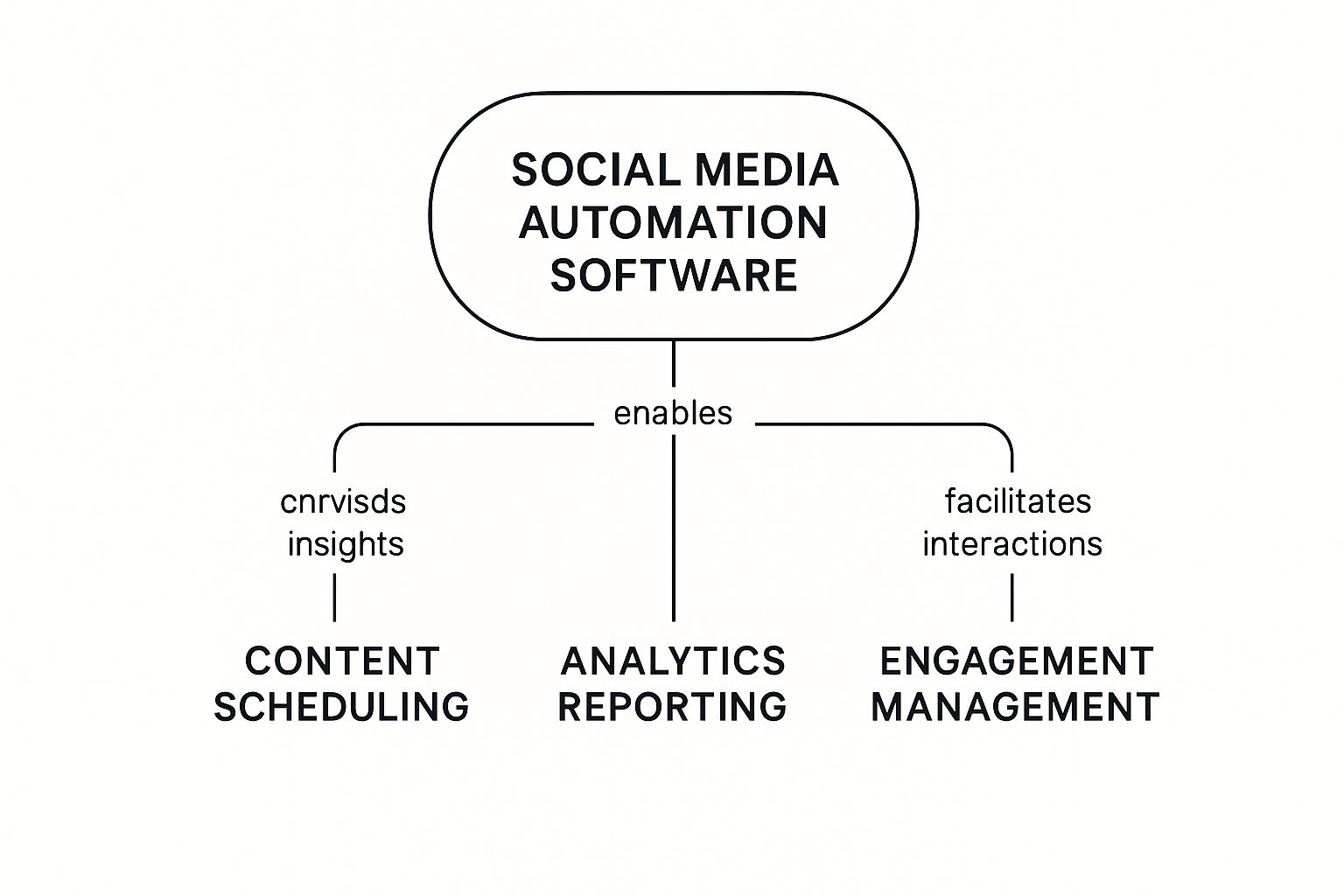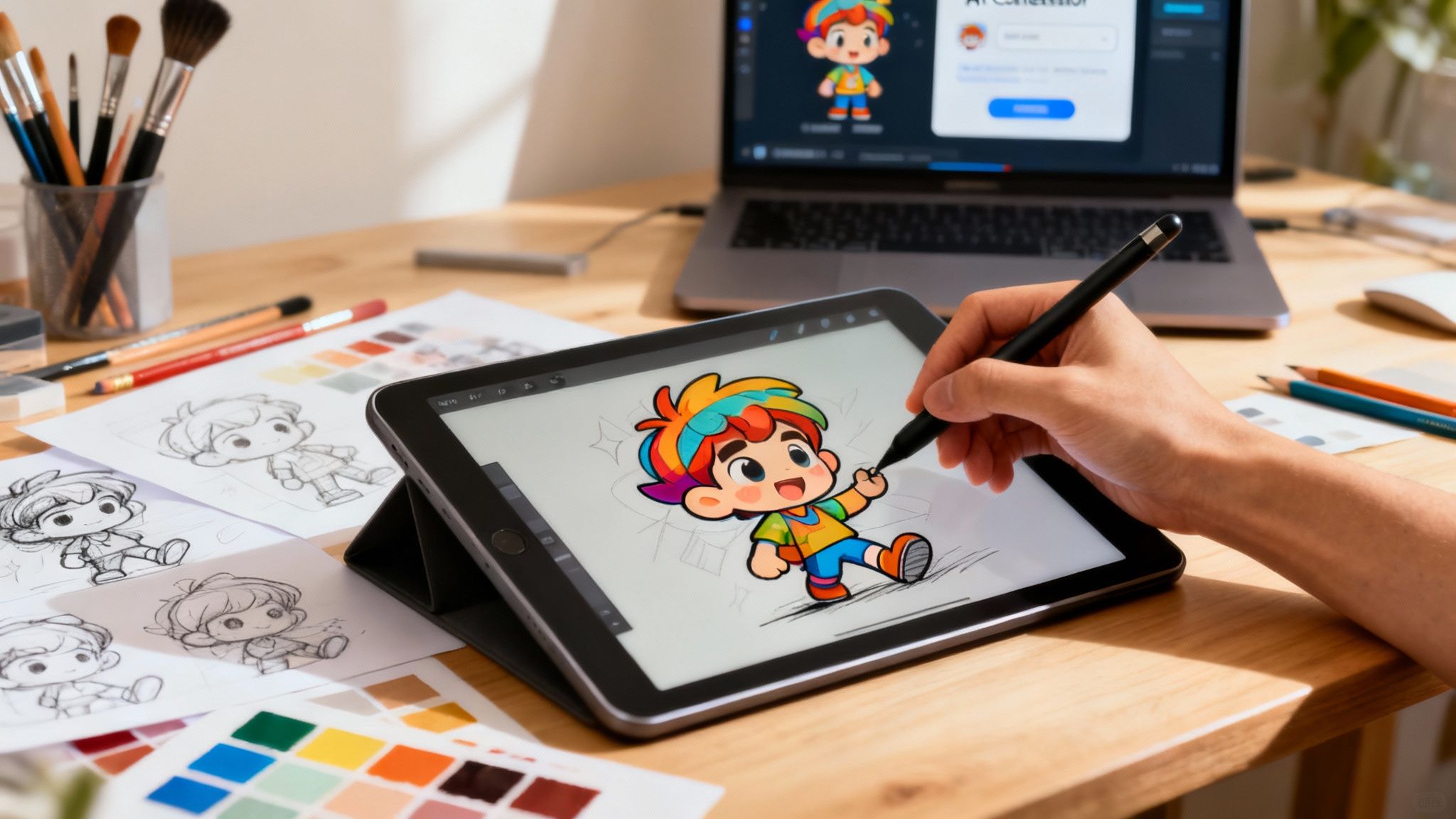
Meta Description: Discover how social media automation software can save you time, scale your content, and drive real results. A guide for marketers, creators, and agencies.
Juggling content, scheduling posts, engaging with comments, and analyzing performance across multiple social media platforms can feel like an impossible task. For many digital marketers and content creators, this constant grind is a major pain point, leading to burnout and inconsistent results. What if you could reclaim hours every week while actually improving your social media presence? This guide explores how social media automation software provides the solution, acting as a strategic partner to streamline your workflow and help you focus on what truly matters: creating great content and building genuine connections.
What Is Social media automation software?
Let's clear up a common misconception: social media automation isn't about "setting and forgetting" your content or replacing the human touch. Your creativity and strategic mind are still the stars of the show. Instead, this software acts as your behind-the-scenes assistant, handling the repetitive, time-consuming tasks that bog you down. Think of it as a platform for efficiency and consistency, freeing you up to focus on high-impact activities like community engagement and content strategy. It’s the key to working smarter, not harder.
Manual vs. Automated Social Media Management
The difference between managing social media by hand versus using a dedicated platform is night and day. One is a reactive, daily grind, while the other is a proactive, sustainable system for growth. For a creator or a marketing agency, this shift is transformative.
Here’s a quick comparison:
| Aspect | Manual Management | Automated Management |
|---|---|---|
| Efficiency | Highly time-consuming; requires constant platform switching and manual posting. | Schedules content in batches, freeing up hours of daily work. |
| Consistency | Prone to gaps and inconsistent posting times, especially across time zones. | Maintains a steady, optimized posting schedule 24/7 without fail. |
| Scalability | Extremely difficult to scale; adding more accounts or platforms exponentially increases workload. | Easily manages dozens of profiles from one dashboard, making growth manageable. |
| Analytics | Requires manually collecting data from each platform, often with limited insights. | Gathers cross-platform data into unified reports, revealing deeper performance trends. |
| Collaboration | Messy and insecure; often involves sharing passwords and using spreadsheets. | Provides secure team access with defined roles and approval workflows. |
At a glance, you can see how automation transforms a chaotic manual process into a structured, strategic workflow. A good tool gives you a command center for all your social media activities. Instead of hopping between Twitter, LinkedIn, and Instagram, you get a single, clear view of everything.

A professional dashboard like the one from Hootsuite shown above offers a high-level overview that's simply impossible to replicate with manual methods. By automating routine tasks, you're not just saving time—you're gaining the strategic insight needed to make smarter marketing decisions and scale your efforts without scaling your workload.
The Strategic Perks of Automating Your Social Media
While saving time is a fantastic benefit of using social media automation software, the real power is strategic. Automation helps you build a stronger, more consistent, and data-backed presence that supports business growth. Think of it as creating an "always-on" brand. While you’re logged off, your software is publishing content at optimal times to reach audiences in different time zones. This consistency builds trust and keeps your brand top-of-mind.

Scale Your Growth and Maintain Consistency
Imagine you're a marketing agency managing a dozen client accounts. Manually posting for each would be a logistical nightmare. With automation, a small team can execute complex content schedules for multiple brands from a single dashboard, ensuring no post is ever missed. This scalability is also a game-changer for e-commerce stores. An online shop can schedule an entire month of promotions, new product drops, and customer stories in one afternoon, perfectly timing campaigns without any last-minute stress. Automation turns social media from a reactive chore into a proactive, strategic channel.
Drive Measurable Business Results
Ultimately, social media marketing is about achieving tangible results. Automation tools connect your social efforts directly to business goals like lead generation and sales. By analyzing cross-platform performance data, you can pinpoint exactly which content resonates with your audience and drives the most engagement. This data-first approach lets you fine-tune your strategy, doubling down on what works and optimizing posting times. This shift toward data-driven decisions is why the broader marketing automation market, which includes these tools, is expected to hit $15.58 billion by 2030, according to Grand View Research's market analysis.
Once automation handles scheduling, your team can focus on what really matters:
- Deeper Community Engagement: More time for real conversations and relationship-building.
- Creative Content Development: Less pressure of daily posting means more energy for brainstorming high-quality content.
- Strategic Analysis: Analyze what’s working and why to make smarter decisions for your next campaign.
To learn more, check out our guide on marketing automation best practices.
👉 Try MediaWorkbench.ai for free – schedule your posts and generate AI content in one place!
What to Look For in a Great Automation Platform
When you start researching social media automation software, you'll find they aren't all the same. Some are simple schedulers, while others are comprehensive command centers. To pick the right one, you need to know which features truly move the needle for marketers and creators. A dashboard from a tool like Sprout Social exemplifies this, offering a clean, single-pane-of-glass view to manage everything from publishing to engagement.

This unified dashboard is the heart of modern automation, providing a bird's-eye view that's impossible to get when juggling platforms manually.
Core Scheduling and Content Management
At its core, automation is about planning. The best platforms offer visual, drag-and-drop content calendars that map out your entire strategy. But look for advanced features that save even more time:
- Content Queues: Group content by category (e.g., blog posts, promotions) and let the tool publish them at optimal times.
- Evergreen Content Recycling: Automatically re-share top-performing posts to maximize their lifespan and keep your feeds active.
- AI-Powered Content Generation: Platforms like MediaWorkbench.ai build AI directly into the workflow. You can draft captions, brainstorm ideas, or even create images, going from a blank slate to a scheduled post in minutes. For more ideas, our guide to social media marketing templates is a great starting point.
Analytics and Performance Reporting
You can't improve what you don't measure. For any serious marketer, robust analytics are non-negotiable. A top-tier tool will automatically pull data from all connected accounts into easy-to-read, customizable reports. This data reveals what content clicks with your audience, the best times to publish, and how your community is growing. Real automation isn’t just about posting more; it’s about learning more from what you post, allowing you to prove ROI and make smarter moves with your next campaign.
How Professionals Win with Automation: Real-World Use Cases
Let's move past theory and see how social media automation software solves real problems for businesses and creators, turning tedious tasks into a competitive advantage.
Use Case 1: The Digital Marketing Agency
For a busy agency, the biggest challenge is managing multiple client accounts without errors. Automation software becomes their mission control. With a feature like custom approval workflows, a junior team member can draft posts, which are then automatically sent to a manager and even the client for sign-off before going live. This process slashes errors, ensures brand voice consistency, and keeps every client happy—all from a single dashboard.
Use Case 2: The Solopreneur and Content Creator
For a solopreneur or creator, time is their most valuable asset. Automation is the secret weapon that lets them "clone" themselves. A creator can use one day a month for "batching"—creating all their content for the next 30 days. Using a tool like MediaWorkbench.ai, they can upload and schedule everything at once. This transforms their workflow from a daily scramble into a calm, strategic operation, ensuring a consistent presence that engages their audience even while they're on vacation.
Use Case 3: The Small Business
Most small businesses can't afford a full-time social media manager. Automation software is a powerful, budget-friendly equalizer. A local boutique, for example, can use it to:
- Schedule promotional posts for a holiday sale weeks in advance.
- Recycle evergreen content, like their brand story or best-sellers.
- Monitor brand mentions and reviews to engage with customers instantly.
This systematic approach helps them compete with larger brands and drive real foot traffic without being glued to their phone 24/7.
How to Choose the Right Automation Software

You understand the "what" and "why." Now for the "how." The secret is finding the tool that fits your unique workflow, budget, and goals. The market is booming, which means more choice but also more potential for overwhelm. A little strategy goes a long way.
Define Your Core Requirements
Before you get dazzled by features, assess your own needs. A freelance social media manager has different requirements than an in-house corporate team.
Ask yourself:
- What's my budget? Be realistic about your monthly or annual spend.
- Which platforms are essential? Focus on tools that excel on the networks where your audience lives.
- Who is on my team? If you have multiple users, you'll need collaboration features like approval workflows and assigned roles.
This quick self-audit will filter your options and prevent you from overpaying for features you’ll never use.
Evaluate Key Functionality and Usability
Once you have a shortlist, it's time to test them out. The right software should feel intuitive, not like another complicated system to learn. Look for a clean user interface (UI) and essential integrations with tools you already use, like Canva or your CRM.
Pro Tip: Always take advantage of free trials. Use that time to schedule posts, explore the analytics, and see if the tool genuinely makes your job easier. Ultimately, you’re looking for a platform that slots right into your existing social media strategy and becomes an indispensable part of your marketing toolkit.
Conclusion
Social media automation software is not about replacing the human element of your marketing; it's about enhancing it. By automating the repetitive, time-consuming tasks, you free yourself to focus on what truly drives growth: crafting creative strategies, analyzing performance data, and building genuine relationships with your audience. You can save hours, maintain a consistent brand presence across all channels, and gain clear, data-backed insights into what's working. With the right platform, you’ll transform social media from a daily chore into a powerful, predictable growth engine.
Ready to see how this works for you? MediaWorkbench.ai brings smart scheduling and AI-powered content tools together to save you hours every single week. Start your free trial today and experience a smarter workflow!

